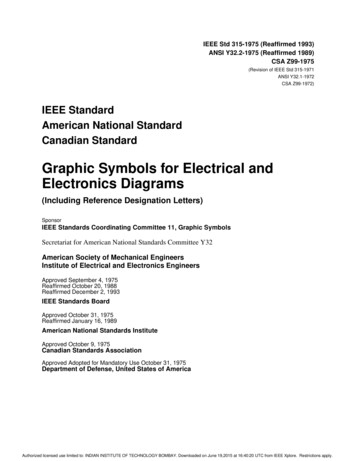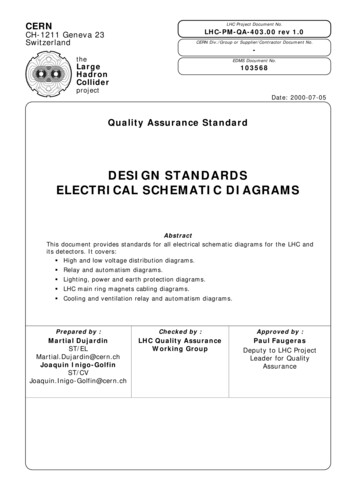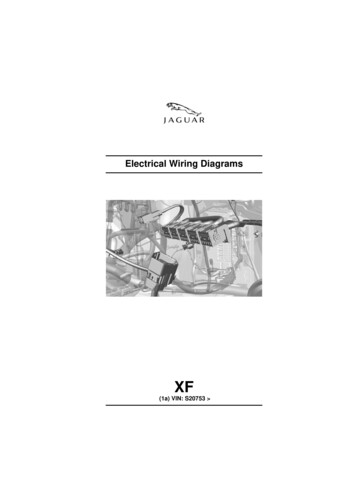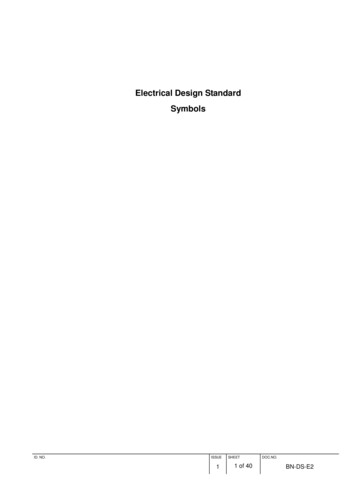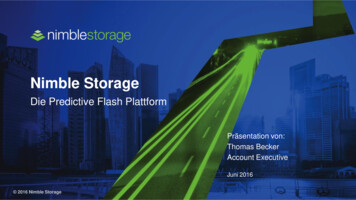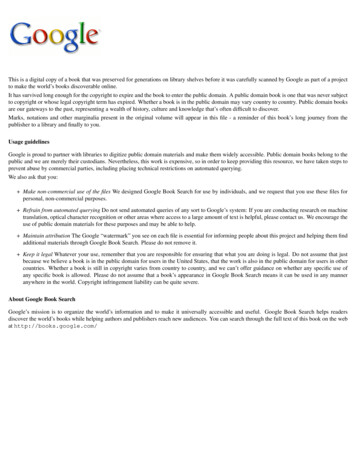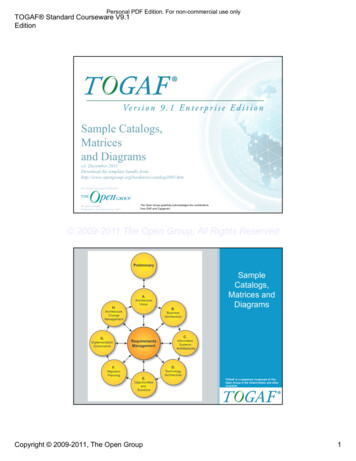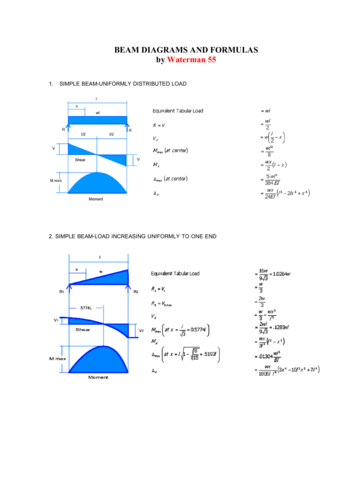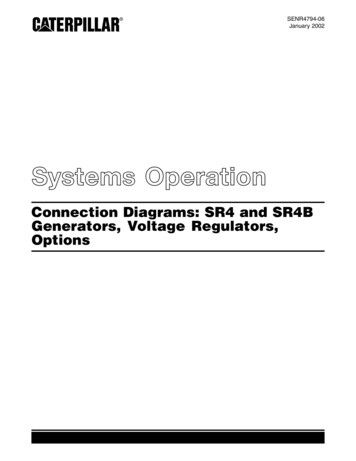
Transcription
Electrical Symbols and LineDiagramsChapter 3Material taken from Chapter 3 of Electric Motor Controls, G. Rockis, 2001One-Line Diagrams One-line diagram – a diagram that usessingle lines and graphic symbols toindicate the path and components of anelectrical circuit.One-line diagrams are used wheninformation about a circuit is requiredbut detail of the actual wire connectionsand operation of the circuit are not.1
Line Diagrams A line (ladder) diagram is a diagram thatshows the logic of an electrical circuit orsystem using standard symbols.A line diagram is used to show therelationship between circuits and theircomponents but not the actual locationof the components.Line diagrams provide a fast, easyunderstanding of the connections anduse of components.Electric Motor Controls, G. Rockis, 20012
Electric Motor Controls, G. Rockis, 2001Wiring Diagrams Wiring (connection) diagram – adiagram that shows the connection ofan installation or its component devicesor parts.Wiring diagrams show, as closely aspossible, the actual location of eachcomponent in a circuit, including thecontrol circuit and the power circuit.3
Electric Motor Controls, G. Rockis, 2001Manual Control Circuits Manual control circuit – any circuit thatrequires a person to initiate an action for thecircuit to operate.A line diagram may be used to illustrate amanual control circuit of a pushbuttoncontrolling a pilot light.A line diagram may be used to illustrate thecontrol and protection of a 1ϕ motor using amanual starter with overload protection.4
Electric Motor Controls, G. Rockis, 2001Electric Motor Controls, G. Rockis, 20015
Automatic Control Circuits Automatically-controlled devices havereplaced many jobs that were onceperformed manually.As a part of automation, control circuitsare designed to replace manual devices.Electric Motor Controls,G. Rockis, 20016
Magnetic Control Circuits Although manual controls are compactand sometimes less expensive thanmagnetic controls, industrial andcommercial installations often requirethat electrical control equipment belocated in one area while the loaddevice is located in another.Solenoids, contactors, and magneticmotor starters are used for remotecontrol of devices.Solenoids A solenoid is anelectrical devicethat convertselectrical energyinto a linearmechanical force.Electric Motor Controls,G. Rockis, 20017
Electric Motor Controls, G. Rockis, 2001Contactors Contactor – a control device that uses asmall control current to energize or deenergize the load connected to it.A contactor does not include overloadprotection.A contactor has a frame, plunger, andcoil like a solenoid.8
Contactors The action of the plunger, however, isdirected to close (or open) sets ofcontacts.The closing of the contacts allowselectrical devices to be controlled fromremote locations.Electric Motor Controls, G. Rockis, 20019
Electric Motor Controls, G. Rockis, 2001Magnetic Motor Starters A magnetic motor starter is anelectrically-operated switch (contactor)that includes motor overload protection.Magnetic motor starters are identical tocontactors except that they haveoverloads attached to them.10
Magnetic Motor Starters The overloads have heaters orelectronic overloads (located in thepower circuit) which sense excessivecurrent flow to the motor.The heaters open the NC overloadcontacts (located in the control circuit)when the overload becomes dangerousto the motor.Electric Motor Controls, G. Rockis, 200111
Logic Applied to LineDiagramsChapter 4Material taken from Chapter 4 of Electric Motor Controls,G. Rockis, 2001Basic Rules The electrical industry has established auniversal set of symbols and rules onhow line diagrams (circuits) are laidout.12
One Load Per Line No more than one load should beplaced in any one circuit line betweenL1 and L2.A pilot light can be connected into acircuit with single-pole switch.Electric Motor Controls, G. Rockis, 200113
One Load Per Line Two loads must not be connected in series onone line of a line diagram.If the two loads are connected in series, thenthe voltage between L1 and L2 must divideacross both loads when S1 is closed.The result is that neither device receives theentire 120 V necessary for proper operation.One Load Per Line Loads must beconnected inparallel when morethan one load mustbe connected in theline diagram.This circuit has twolines, one for thepilot light and onefor the solenoid.Electric Motor Controls, G. Rockis, 200114
Load Connections A load is the electrical device in the linediagram that uses the electrical powerfrom L1 to L2.Control relay coils, solenoids, and pilotlights are loads that are connecteddirectly or indirectly to L2.Electric Motor Controls, G. Rockis, 200115
Load Connections Magnetic motor starter coils areconnected to L2 indirectly throughnormally closed overload contacts.Anywhere from 1 to 3 NC overloadcontacts are shown between thestarter and L2 in all line diagrams.To avoid confusion, it is commonpractice to draw one set of NCoverload contacts and mark thesecontacts all overloads (OLs).Electric Motor Controls, G. Rockis, 200116
Control Device Connections Control devices are connected betweenL1 and the operating coil (or load).Operating coils of contactors andstarters are activated by control devicessuch as pushbuttons, limit switches,and pressure switches.Electric Motor Controls, G. Rockis, 2001Figure 4-5. Control devices are connected between L1 andthe operating coil.17
Control Device Connections Each line includes at least one controldevice.The operating coil is ON all the time ifno control device is included in a line.A circuit may contain as many controldevices as is required to make theoperating coil function as specified.Electric Motor Controls, G. Rockis, 200118
Line Number Reference Each line in a linediagram should benumbered startingwith the top lineand reading down.Electric Motor Controls, G. Rockis, 2001Numerical Cross-ReferenceSystems Numerical cross-reference systems arerequired to trace the action of a circuitin complex line diagrams.Common rules help to quickly simplifythe operation of complex circuits.19
NO Contacts Relays, contactors, and magnetic motorstarters normally have more than one set ofauxiliary contacts.These contacts may appear at severaldifferent locations in the line diagram.Numerical cross-reference systems quicklyidentify the location and type of contactscontrolled by a given device.A numerical cross-reference system consistsof numbers in parenthesis to the right of theline diagram.Electric Motor Controls,G. Rockis, 200120
NC Contacts In addition to NO contacts, there arealso NC contacts in a circuit.To differentiate between NO and NC,NC contacts are indicated as a numberwhich is underlined.Electric Motor Controls,G. Rockis, 200121
Wire-Reference Numbers Each wire in a control circuit isassigned a reference point (number)on a line diagram to keep track of thedifferent wires that connect thecomponents in the circuit.Each reference point is assigned areference number.Reference numbers are normallyassigned from the top left to thebottom right.Electric Motor Controls,G. Rockis, 200122
Manufacturer’s TerminalNumbers Manufacturers of electrical relays, timers,counters, etc., include numbers on the terminalconnection points.These terminal numbers are used to identifyand separate the different component parts(coil, NC contacts, etc) included on theindividual pieces of equipment.Manufacturer’s terminal numbers are oftenadded to a line diagram after the specificequipment to be used in the control circuit isidentified.Electric Motor Controls,G. Rockis, 200123
Signals, Decisions, and Action A circuit must respond as designed,without any changes.To accomplish this consistency, allcontrol circuits are composed of threebasic sections: the signals, thedecisions, and the action sections.Electric Motor Controls, G. Rockis, 200124
Signals A signal starts or stops the flow ofcurrent by closing or opening thecontrol device’s contacts.Current is allowed to flow through thecontrol device if the contacts areclosed.Current is not allowed to flow throughthe control device if the contacts areopened.Signals Pushbuttons, limit switches, flowswitches, foot switches, temperatureswitches, and pressure switches may beused as the signal section of a controlcircuit.25
Signals All signals depend on some conditionthat must take place. This condition canbe manual, mechanical, or automatic.A manual condition is any input into thecircuit by a person. Foot switches andpushbuttons are control devices thatrespond to a manual condition.Signals A mechanical condition is any input intothe circuit by a mechanically movingpart.A limit switch is a control device thatresponds to a mechanical condition.26
Signals An automatic condition is any inputwhich responds automatically tochanges in a system.Flow switches, temperature switches,and pressure switches respond toautomatic conditions.Decisions The decision section of a circuitdetermines what work is to be doneand in what order the work is to occur.The decision section of a circuit adds,subtracts, sorts, selects, and redirectsthe signals from the control devices tothe load.27
Decisions The way the control devices areconnected into the circuit gives thecircuit logic.The basic logic functions are AND, OR,NOT, NOR, and NAND logic.The decision section of the circuitaccepts informational input (signals),makes logical decisions based on theway the control devices are connectedinto the circuit, and provides theoutput signal that controls the load.Action Once a signal is generated and thedecision has been made within a circuit,some action (work) should result.In most cases it is the operating coil inthe circuit which is responsible forinitiating the action.28
Action This action is direct when devices suchas motors, lights, and heating elementsare turned ON as a direct result of thesignal and the decision.This action is indirect when the coils insolenoids, magnetic starters, and relaysare energized.Logic Functions Control devices such as pushbuttons,limit switches, and pressure switchesare connected into a circuit so that thecircuit can function in a predeterminedmanner.All control circuits are basic logicfunctions.Logic functions are common to allareas of industry.29
AND Logic AND logic is used in industry when twopushbuttons are connected in series tocontrol a solenoid.Electric Motor Controls, G. Rockis, 2001OR Logic OR logic is used in industry when apushbutton and a temperature switch areconnected in parallel.Electric Motor Controls, G. Rockis, 200130
AND/OR Logic Combination The decision section of any circuit maycontain one or more logic functions.Electric Motor Controls, G. Rockis, 2001NOT Logic NOT logic has an output if the control signalis OFF.Electric Motor Controls, G. Rockis, 200131
NOR Logic NOR logic is an extension of NOT logic in that twoor more NC contacts in series are used to control aload.In this circuit, additional operator safety is providedby adding several emergency stop pushbuttons(NOT logic) to the control circuit.Electric Motor Controls, G. Rockis, 2001NAND Logic NAND logic is an extension of NOT logic inwhich two or more NC contacts areconnected in parallel to control a load.Electric Motor Controls, G. Rockis, 200132
Memory In industrial control circuits, it is more commonto find pushbuttons with return spring contacts(momentary contacts) than those withmechanically stay held in one position(maintained contacts).Auxiliary contacts are added to give circuitswith pushbuttons memory.Electric Motor Controls, G. Rockis, 2001Start/Stop Stations Controlling MagneticStartersElectric Motor Controls, G. Rockis, 200133
Two Magnetic Starters Operated by TwoStart/Stop Stations with CommonEmergency StopElectric Motor Controls, G. Rockis, 2001Start/Stop Station Controlling Two orMore Magnetic StartersElectric Motor Controls, G. Rockis, 200134
Pressure Switch with Pilot LightIndicating Activation Pilot lights are manufactured in avariety of colors, shapes, and sizes tomeet the needs of industry.The illumination of these lights signalsan operator that any one of a sequenceof events may be taking place.Electric Motor Controls, G. Rockis, 200135
Start/Stop Station with Pilot LightIndicating NO Device Activation Pilot lights may be used to show when anoperation is stopped as well as when it isstarted.Electric Motor Controls, G. Rockis, 2001Pushbutton Sequence Control Conveyor systems often require oneconveyor system to feed boxes or othermaterials onto another conveyor system.A circuit is needed to prevent the pileupof material on the second conveyor if thesecond conveyor is stopped.A sequence control circuit does not letthe first conveyor operate unless thesecond conveyor has started and isrunning.36
Electric Motor Controls, G. Rockis, 200137
device is located in another. . counters, etc., include numbers on the terminal connection points. These terminal numbers are used to identify and separate the different component parts (coil, NC contacts, etc) included on the individual pieces of equipment. Manufacturer’s terminal numbers are often added to a line diagram after the specific equipment to be used in the control circuit is .

